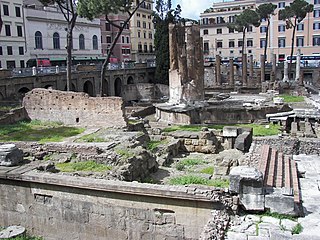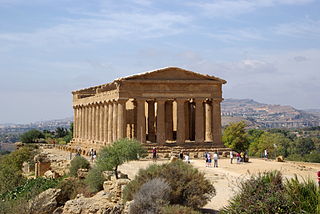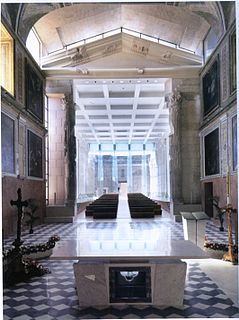
Assisi is a town and comune of Italy in the Province of Perugia in the Umbria region, on the western flank of Monte Subasio.

Spoleto is an ancient city in the Italian province of Perugia in east-central Umbria on a foothill of the Apennines. It is 20 km (12 mi) S. of Trevi, 29 km (18 mi) N. of Terni, 63 km (39 mi) SE of Perugia; 212 km (132 mi) SE of Florence; and 126 km (78 mi) N of Rome.

The Temple of Portunus or Temple of Fortuna Virilis is a Roman temple in Rome, Italy, one of the best preserved of all Roman temples. Its dedication remains unclear, as ancient sources mention several temples in this area of Rome, without saying enough to make it clear which this is. It was called the Temple of Fortuna Virilis from the Renaissance, and remains better known by this name. If dedicated to Portunus, the god of keys, doors and livestock, and so granaries, it is the main temple dedicated to the god in the city.

Santa Maria sopra Minerva is one of the major churches of the Roman Catholic Order of Preachers in Rome, Italy. The church's name derives from the fact that the first Christian church structure on the site was built directly over the ruins or foundations of a temple dedicated to the Egyptian goddess Isis, which had been erroneously ascribed to the Greco-Roman goddess Minerva.

I quattro libri dell'architettura is a treatise on architecture by the architect Andrea Palladio (1508–1580), written in Italian. It was first published in four volumes in 1570 in Venice, illustrated with woodcuts after the author's own drawings. It has been reprinted and translated many times, often in single-volume format.

The Temple of Jupiter Optimus Maximus, also known as the Temple of Jupiter Capitolinus was the most important temple in Ancient Rome, located on the Capitoline Hill. It was surrounded by the Area Capitolina, a precinct where numerous shrines, altars, statues and victory trophies were displayed.

Terracina is an Italian city and comune of the province of Latina, located on the coast 56 km (35 mi) southeast of Rome on the Via Appia. The site has been continuously occupied since antiquity.

The Temple of Vesta, or the aedes, is an ancient edifice in Rome, Italy. The temple is located in the Roman Forum near the Regia and the House of the Vestal Virgins. The Temple of Vesta housed Vesta's holy fire, which was a symbol of Rome's safety and prosperity. The temple's most recognizable feature is its circular footprint. Since the worship of Vesta began in private homes, the architecture seems to pay homage to the architecture of early Roman homes. The temple used Greek architecture with Corinthian columns, marble, and had a central cella. The surviving structure indicates that there were twenty Corinthian columns built on a podium fifteen meters in diameter. The roof probably had a vent at the apex to allow smoke to release.

Largo di Torre Argentina is a square in Rome, Italy, with four Roman Republican temples and the remains of Pompey's Theatre. It is in the ancient Campus Martius.

The Temple of Hercules Victor or Hercules Olivarius is a Roman temple in Piazza Bocca della Verità, in the area of the Forum Boarium close to the Tiber in Rome, Italy. It is a tholos - a round temple of Greek 'peripteral' design completely encircled by a colonnade. This layout caused it to be mistaken for a temple of Vesta until it was correctly identified by Napoleon's Prefect of Rome, Camille de Tournon.

Santa Bibiana is a small Baroque style, Roman Catholic church in Rome devoted to Saint Bibiana. The church façade was designed and built by Gian Lorenzo Bernini, who also produced a sculpture of the saint holding the palm leaf of martyrs.

The Temple of Saturn was an ancient Roman temple to the god Saturn, in what is now Rome, Italy. Its ruins stand at the foot of the Capitoline Hill at the western end of the Roman Forum. The original dedication of the temple is traditionally dated to 497 BC, but ancient writers disagreed greatly about the history of this site.

The Basilica of Saint Mary of the Angels is a Papal minor basilica situated in the plain at the foot of the hill of Assisi, Italy, in the frazione of Santa Maria degli Angeli.

Italy has a very broad and diverse architectural style, which cannot be simply classified by period or region, due to Italy's division into various small states until 1861. This has created a highly diverse and eclectic range in architectural designs. Italy is known for its considerable architectural achievements, such as the construction of aqueducts, temples and similar structures during ancient Rome, the founding of the Renaissance architectural movement in the late-14th to 16th century, and being the homeland of Palladianism, a style of construction which inspired movements such as that of Neoclassical architecture, and influenced the designs which noblemen built their country houses all over the world, notably in the United Kingdom, Australia and the United States of America during the late-17th to early 20th centuries.

The Temple of Antas is an ancient Carthaginian-Roman temple in the commune of Fluminimaggiore, southern Sardinia, Italy. It is located in an area colonised by the Carthaginians and then by the Romans, attracted by its silver and lead deposits.

The Church of Santa Maria Maggiore, also known as Sanctuary of the Spoliation, is a church in Assisi, Umbria, central Italy.

The Temple of Concordia is an ancient Greek temple in the Valle dei Templi in Agrigento on the south coast of Sicily, Italy. It is the largest and best-preserved Doric temple in Sicily and one of the best-preserved Greek temples in general, especially of the Doric order.

The Temple of Athena is a hexastyle peripteral Doric temple built in Syracuse in the 5th century BC by the tyrant Gelo after his victory over the Carthaginians at the Battle of Himera. The temple was preceded by a cult site which dated back to the 8th century BC, with an altar discovered in excavation at the beginning of the twentieth century, and by an earlier temple from the middle of the sixth century BC.

Pozzuoli Cathedral or the Basilica of San Procolo martire is the main Roman Catholic church in Pozzuoli and the seat of the Diocese of Pozzuoli. It sits at the top of the Rione Terra and is built around an ancient Roman temple.

The Temple of Jupiter Anxur is an Ancient Roman temple that is located in Terracina, Italy.




















